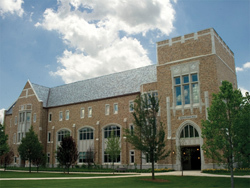A new era in engineering research at the University of Notre Dame will be officially marked Friday (Sept. 3) with the dedication of Stinson-Remick Hall, a 160,000-square-foot facility that houses a nano technology research center, an 9,000-square-foot semiconductor processing and device fabrication clean room, and an undergraduate interdisciplinary learning center.
The building also houses Holy Cross Chapel, believed to be the only chapel inside a university engineering building in the country.
The dedication ceremonies will include a private Mass and a blessing of the building at 5 p.m.

The new building is called Stinson-Remick Hall in honor of principal benefactors Kenneth and Ann Stinson and Jack and Mary Ann Remick. Stinson is a 1964 Notre Dame graduate and a member of the Board of Trustees. Jack Remick, a 1959 graduate, is a member of the University’s advisory council for the College of Engineering and a gift from Mary Ann Remick created an endowment for visiting fellows at Notre Dame’s Center for Ethics and Culture.
The learning center is named in honor of major benefactors Ted and Tracy McCourtney. A 1960 Notre Dame graduate, Ted McCourtney is an emeritus member of the Board of Trustees.
Researchers in Notre Dame’s Center for Nano Science and Technology explore new device concepts and associated architectures that are enabled by novel phenomena on the nanometer scale. Established in 1999, the center is under the direction of Wolfgang Porod, Frank. M Freimann Professor of Electrical Engineering.
The Notre Dame Energy Center was created in 2005 under the direction of Joan Brennecke, Keating-Crawford Professor of Chemical and Biomolecular Engineering. Faculty members associated with the center are seeking to develop new energy technologies, based on carbon dioxide sequestration in ionic liquids, new materials for nuclear energy utilization and related energy efficiency research to meet a compelling national and international challenge.
A major energy research program located in the building is a federal Energy Frontier Research Center led by Peter Burns and funded with an $18.5-million U.S. Department of Energy grant. Research at the center seeks to understand and control materials that contain actinides at the nanoscale. The research is intended to lay the scientific foundation for advanced nuclear energy systems that may provide much more energy while creating less nuclear waste.
Another initiative housed in Stinson-Remick is the Midwest Institute for Nanoelectronics Discovery (MIND), a consortium of academic, industry and government partners led by Notre Dame which explores and develops advanced devices, circuits and nanosystems with performance capabilities beyond conventional devices.
The interdisciplinary learning center is four times the size of its former location in Cushing Hall. The center provides undergraduate students with a blend of computer work stations, library resources and laboratory space.
The semiconductor processing and device fabrication clean room will be the first such facility at Notre Dame.
Stinson-Remick also is home to Notre Dame’s Advanced Diagnostics and Therapeutics initiative (AD&T), an interdisciplinary research initiative focused on developing diagnostic and therapeutic technologies at the smallest molecular scales to address a diverse set of health and environmental challenges.
Also housed in Stinson-Remick is the Notre Dame Nanofabrication Facility (NDNF), which features comprehensive facilities for developing nano- and microelectronic materials and devices. NDNF serves approximately 150 researchers across the University each year as well as faculty from many others universities and research facilities across the country.
The new building also houses the Notre Dame Integrated Imaging Facility, which serves the science and engineering research communities by integrating three areas of the University’s imaging expertise: electron microscopy, optical microscopy and in vivo imaging.